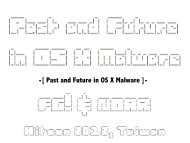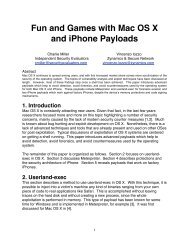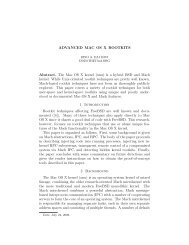iOS Kernel Heap Armageddon
iOS Kernel Heap Armageddon
iOS Kernel Heap Armageddon
Create successful ePaper yourself
Turn your PDF publications into a flip-book with our unique Google optimized e-Paper software.
<strong>iOS</strong> <strong>Kernel</strong> <strong>Heap</strong> <strong>Armageddon</strong><br />
Stefan Esser <br />
http://www.sektioneins.de<br />
SyScan Singapore 2012
Who am I?<br />
Stefan Esser<br />
• from Cologne / Germany<br />
• in information security since 1998<br />
• PHP core developer since 2001<br />
• Month of PHP Bugs and Suhosin<br />
• recently focused on iPhone security (ASLR, jailbreak)<br />
• Head of Research and Development at SektionEins GmbH<br />
Stefan Esser • <strong>iOS</strong> <strong>Kernel</strong> <strong>Heap</strong> <strong>Armageddon</strong> • April 2012 •<br />
2
Recap...<br />
• public <strong>iOS</strong> kernel heap research can be summarized as<br />
• there is a kernel heap zone allocator<br />
• it comes with heap meta data<br />
• which can be exploited<br />
• here is one possible way<br />
Stefan Esser • <strong>iOS</strong> <strong>Kernel</strong> <strong>Heap</strong> <strong>Armageddon</strong> • April 2012 •<br />
3
So what is this talk about?<br />
• zone allocator recap<br />
• other kernel heap managers / wrappers<br />
• recent changes in the allocators<br />
• cross zone attacks<br />
• kernel level application data overwrite attacks<br />
• generic heap massage technique<br />
Stefan Esser • <strong>iOS</strong> <strong>Kernel</strong> <strong>Heap</strong> <strong>Armageddon</strong> • April 2012 •<br />
4
Part I<br />
Zone Allocator Recap<br />
Stefan Esser • <strong>iOS</strong> <strong>Kernel</strong> <strong>Heap</strong> <strong>Armageddon</strong> • April 2012 •<br />
5
Some <strong>Kernel</strong> Zones<br />
$ zprint kalloc<br />
elem cur max cur max cur alloc alloc<br />
zone name size size size #elts #elts inuse size count<br />
-----------------------------------------------------------------------------zones<br />
460 84K 90K 187 200 167 20K 44<br />
vm.objects 148 487K 512K 3375 3542 3103 4K 27 C<br />
vm.object.hash.entries 20 19K 512K 1020 26214 704 4K 204 C<br />
maps 168 11K 40K 72 243 61 4K 24<br />
VM.map.entries 48 203K 1024K 4335 21845 3859 4K 85 C<br />
Reserved.VM.map.entries 48 27K 1536K 597 32768 191 4K 85<br />
VM.map.copies 48 3K 16K 85 341 0 4K 85 C<br />
pmap 2192 134K 548K 63 256 52 20K 9 C<br />
...<br />
tcp_bwmeas_zone 32 0K 4K 0 128 0 4K 128 C<br />
igmp_ifinfo 112 3K 8K 36 73 3 4K 36 C<br />
ripzone 268 3K 1072K 15 4096 0 4K 15 C<br />
in_multi 136 3K 12K 30 90 2 4K 30 C<br />
ip_msource 28 0K 4K 0 146 0 4K 146 C<br />
in_msource 20 0K 4K 0 204 0 4K 204 C<br />
in_ifaddr 156 3K 12K 26 78 1 4K 26 C<br />
ip_moptions 52 3K 4K 78 78 1 4K 78 C<br />
llinfo_arp 36 0K 12K 0 341 0 4K 113 C<br />
unpzone 152 27K 1132K 182 7626 129 4K 26 C<br />
fs-event-buf 64 64K 64K 1024 1024 0 4K 64<br />
bridge_rtnode 40 0K 40K 0 1024 0 4K 102 C<br />
vnode.pager.structures 20 19K 196K 1020 10035 655 4K 204 C<br />
kernel_stacks 16384 1232K 1232K 77 77 33 16K 1 C<br />
page_tables 4096 6688K ---- 1672 ---- 1672 4K 1 C<br />
kalloc.large 64898 2218K 8961K 35 141 35 63K 1<br />
Stefan Esser • <strong>iOS</strong> <strong>Kernel</strong> <strong>Heap</strong> <strong>Armageddon</strong> • April 2012 •<br />
6
<strong>iOS</strong> <strong>Kernel</strong> Zone Allocator 101<br />
• kernel heap is divided into so called zones<br />
• each zone starts with a first chunk of memory (usually 1 page)<br />
0x000<br />
0x1000<br />
Stefan Esser • <strong>iOS</strong> <strong>Kernel</strong> <strong>Heap</strong> <strong>Armageddon</strong> • April 2012 •<br />
7
<strong>iOS</strong> <strong>Kernel</strong> Zone Allocator 101<br />
• each zone is divided into memory blocks of the same size<br />
• all memory allocated within a zone will have the same block size<br />
0x000<br />
0x200<br />
0x400<br />
0x600<br />
0x800<br />
0xA00<br />
0xC00<br />
0xE00<br />
0x1000<br />
Stefan Esser • <strong>iOS</strong> <strong>Kernel</strong> <strong>Heap</strong> <strong>Armageddon</strong> • April 2012 •<br />
8
<strong>iOS</strong> <strong>Kernel</strong> Zone Allocator 101<br />
• zone allocator keeps inbound heap meta data<br />
• first 4 bytes of a free block is a pointer to another free block<br />
0x000<br />
0x200<br />
0x400<br />
0x600<br />
0x800<br />
0xA00<br />
0xC00<br />
0xE00<br />
0x1000<br />
Stefan Esser • <strong>iOS</strong> <strong>Kernel</strong> <strong>Heap</strong> <strong>Armageddon</strong> • April 2012 •<br />
9
<strong>iOS</strong> <strong>Kernel</strong> Zone Allocator 101<br />
• zone allocator keeps a single linked list of free blocks<br />
• last memory block is first in freelist - memory is allocated backwards<br />
0x000<br />
0x200<br />
0x400<br />
0x600<br />
0x800<br />
0xA00<br />
0xC00<br />
0xE00<br />
0x1000<br />
head of freelist<br />
Stefan Esser • <strong>iOS</strong> <strong>Kernel</strong> <strong>Heap</strong> <strong>Armageddon</strong> • April 2012 •<br />
10
<strong>iOS</strong> <strong>Kernel</strong> Zone Allocator 101<br />
• when memory is allocated the head of the freelist is returned<br />
• and the pointer stored in the free memory block is made the new head<br />
before<br />
allocation<br />
head of freelist head of freelist<br />
after<br />
allocation<br />
Stefan Esser • <strong>iOS</strong> 5 - An Exploitation Nightmare? • March 2012 •<br />
11
<strong>iOS</strong> <strong>Kernel</strong> Zone Allocator 101<br />
• in case of a buffer overflow the freelist pointer is overwritten<br />
• next allocation will make attacker controlled pointer the head of freelist<br />
• and the allocation following after will return the injected pointer<br />
adjacent memory blocks<br />
allocated block overflowing into free one<br />
attacker<br />
data<br />
head of freelist<br />
head of freelist<br />
Stefan Esser • <strong>iOS</strong> 5 - An Exploitation Nightmare? • March 2012 •<br />
12
Part II<br />
Other <strong>Heap</strong> Managers and Wrappers<br />
Stefan Esser • <strong>iOS</strong> <strong>Kernel</strong> <strong>Heap</strong> <strong>Armageddon</strong> • April 2012 •<br />
13
Overview Managers and Wrappers<br />
Stefan Esser • <strong>iOS</strong> <strong>Kernel</strong> <strong>Heap</strong> <strong>Armageddon</strong> • April 2012 •<br />
not necessary a complete overview<br />
14
Let‘s have a look at kalloc()<br />
Stefan Esser • <strong>iOS</strong> <strong>Kernel</strong> <strong>Heap</strong> <strong>Armageddon</strong> • April 2012 •<br />
15
kalloc()<br />
• kalloc() is a wrapper around zalloc() and kmem_alloc()<br />
• it adds no additional heap meta data<br />
• caller needs to keep track of allocated size<br />
• for small requests zalloc() is used<br />
• for bigger requests kmem_alloc() is used<br />
• kalloc() registers several zones with names like kalloc.*<br />
Stefan Esser • <strong>iOS</strong> <strong>Kernel</strong> <strong>Heap</strong> <strong>Armageddon</strong> • April 2012 •<br />
16
<strong>iOS</strong> 5 - kalloc() Zones<br />
$ zprint kalloc<br />
elem cur max cur max cur alloc alloc<br />
zone name size size size #elts #elts inuse size count<br />
-----------------------------------------------------------------------------kalloc.8<br />
8 68K 91K 8704 11664 8187 4K 512 C<br />
kalloc.16 16 96K 121K 6144 7776 5479 4K 256 C<br />
kalloc.24 24 370K 410K 15810 17496 15567 4K 170 C<br />
kalloc.32 32 136K 192K 4352 6144 4087 4K 128 C<br />
kalloc.40 40 290K 360K 7446 9216 7224 4K 102 C<br />
kalloc.48 48 95K 192K 2040 4096 1475 4K 85 C<br />
kalloc.64 64 144K 256K 2304 4096 2017 4K 64 C<br />
kalloc.88 88 241K 352K 2806 4096 2268 4K 46 C<br />
kalloc.112 112 118K 448K 1080 4096 767 4K 36 C<br />
kalloc.128 128 176K 512K 1408 4096 1049 4K 32 C<br />
kalloc.192 192 102K 768K 546 4096 507 4K 21 C<br />
kalloc.256 256 196K •1024K <strong>iOS</strong> 5 introduces 784 4096 new kalloc.* 740 zones 4K 16 C<br />
kalloc.384 384 596K 1536K that are 1590 not powers 4096 of 1421 2 4K 10 C<br />
kalloc.512 512 48K 512K 96 1024 46 4K 8 C<br />
kalloc.768 768 97K 768K 130 1024 115 4K 5 C<br />
kalloc.1024 1024 128K •1024K smallest 128 zone is 1024 now for 8 80 byte long 4K 4 C<br />
kalloc.1536 1536 108K 1536K memory blocks 72 1024 59 12K 8 C<br />
kalloc.2048 2048 88K 2048K 44 1024 39 4K 2 C<br />
kalloc.3072 3072 672K •3072K memory 224 block are 1024 aligned 59 to their 12K own 4 C<br />
kalloc.4096 4096 120K 4096K 30 1024 28 4K 1 C<br />
kalloc.6144 6144 420K 576K size their 70 size is a 96 power 38 of 2 12K 2 C<br />
kalloc.8192 8192 176K 32768K 22 4096 20 8K 1 C<br />
Stefan Esser • <strong>iOS</strong> <strong>Kernel</strong> <strong>Heap</strong> <strong>Armageddon</strong> • April 2012 •<br />
17
kfree()<br />
• kfree() is a bit special<br />
• “protection“ against double frees<br />
• keeps track of largest allocated memory block<br />
• attempt to kfree() a larger block is a NOP<br />
Stefan Esser • <strong>iOS</strong> <strong>Kernel</strong> <strong>Heap</strong> <strong>Armageddon</strong> • April 2012 •<br />
18
Let‘s have a look at _MALLOC()<br />
Stefan Esser • <strong>iOS</strong> <strong>Kernel</strong> <strong>Heap</strong> <strong>Armageddon</strong> • April 2012 •<br />
19
_MALLOC()<br />
• _MALLOC() is a wrapper around kalloc()<br />
• it adds the blocksize as additional heap meta data<br />
• so the caller does not need to keep track of allocated size<br />
• it refuses to allocate 0 byte sizes<br />
size<br />
size + 4<br />
⎧<br />
⎪<br />
⎪<br />
⎪<br />
⎨<br />
⎪<br />
⎪<br />
⎪<br />
⎩<br />
data<br />
Stefan Esser • <strong>iOS</strong> <strong>Kernel</strong> <strong>Heap</strong> <strong>Armageddon</strong> • April 2012 •<br />
20
_MALLOC() in <strong>iOS</strong> 4.x<br />
void *_MALLOC(size_t size, int type, int flags)<br />
{<br />
struct _mhead *hdr;<br />
size_t memsize = sizeof (*hdr) + size;<br />
}<br />
if (type >= M_LAST)<br />
panic("_malloc TYPE");<br />
if (size == 0)<br />
return (NULL);<br />
if (flags & M_NOWAIT) {<br />
hdr = (void *)kalloc_noblock(memsize);<br />
} else {<br />
hdr = (void *)kalloc(memsize);<br />
...<br />
}<br />
...<br />
hdr->mlen = memsize;<br />
return (hdr->dat);<br />
refuses to allocate<br />
0 byte big blocks<br />
Stefan Esser • <strong>iOS</strong> <strong>Kernel</strong> <strong>Heap</strong> <strong>Armageddon</strong> • April 2012 •<br />
possible integer overflow<br />
with huge size values<br />
struct _mhead {<br />
size_t mlen;<br />
char dat[0];<br />
}<br />
21
_MALLOC() in <strong>iOS</strong> 5.x<br />
void *_MALLOC(size_t size, int type, int flags)<br />
{<br />
struct _mhead *hdr;<br />
size_t memsize = sizeof (*hdr) + size;<br />
int overflow = memsize < size ? 1 : 0;<br />
}<br />
...<br />
if (flags & M_NOWAIT) {<br />
if (overflow)<br />
return (NULL);<br />
hdr = (void *)kalloc_noblock(memsize);<br />
} else {<br />
if (overflow)<br />
panic("_MALLOC: overflow detected, size %llu", size);<br />
hdr = (void *)kalloc(memsize);<br />
...<br />
}<br />
...<br />
hdr->mlen = memsize;<br />
return (hdr->dat);<br />
Stefan Esser • <strong>iOS</strong> <strong>Kernel</strong> <strong>Heap</strong> <strong>Armageddon</strong> • April 2012 •<br />
integer overflow<br />
detection<br />
attacker can use<br />
overflow to panic<br />
kernel<br />
M_WAIT<br />
22
Overwriting _MALLOC()ed Data<br />
• changing the size of a memory block<br />
• freeing the block will put it in the wrong freelist<br />
• smaller sizes will leak some memory<br />
• bigger sizes will result in buffer overflows<br />
size<br />
size + 4<br />
⎧<br />
⎪<br />
⎪<br />
⎪<br />
⎨<br />
⎪<br />
⎪<br />
⎪<br />
⎩<br />
data<br />
Stefan Esser • <strong>iOS</strong> <strong>Kernel</strong> <strong>Heap</strong> <strong>Armageddon</strong> • April 2012 •<br />
23
What about kern_os_malloc(), new and new[]<br />
Stefan Esser • <strong>iOS</strong> <strong>Kernel</strong> <strong>Heap</strong> <strong>Armageddon</strong> • April 2012 •<br />
24
kern_os_malloc()<br />
• kern_os_malloc() is very similar to _MALLOC()<br />
• it also adds the blocksize as additional heap meta data<br />
• it also refuses to allocate 0 byte sizes<br />
• new and new[] simply wrap around it<br />
• special case: new[0] will allocate 1 byte<br />
size<br />
size + 4<br />
⎧<br />
⎪<br />
⎪<br />
⎪<br />
⎨<br />
⎪<br />
⎪<br />
⎪<br />
⎩<br />
data<br />
Stefan Esser • <strong>iOS</strong> <strong>Kernel</strong> <strong>Heap</strong> <strong>Armageddon</strong> • April 2012 •<br />
25
mcache / slab<br />
could and might fill a whole talk by themself<br />
Stefan Esser • <strong>iOS</strong> <strong>Kernel</strong> <strong>Heap</strong> <strong>Armageddon</strong> • April 2012 •<br />
26
and kernel_memory_allocate ???<br />
Stefan Esser • <strong>iOS</strong> <strong>Kernel</strong> <strong>Heap</strong> <strong>Armageddon</strong> • April 2012 •<br />
27
kernel_memory_allocate<br />
• “master entry point for allocating kernel memory“<br />
• allocates memory in a specific map<br />
• allocates always whole pages<br />
• requests for more than 1 GB fail immediately<br />
• keeps a bunch of heap meta data inside a separate kernel zone<br />
• no inbound meta data<br />
Stefan Esser • <strong>iOS</strong> <strong>Kernel</strong> <strong>Heap</strong> <strong>Armageddon</strong> • April 2012 •<br />
28
Part III<br />
Cross Zone or Cross Memory Allocator Attacks?<br />
Stefan Esser • <strong>iOS</strong> <strong>Kernel</strong> <strong>Heap</strong> <strong>Armageddon</strong> • April 2012 •<br />
29
Cross Zone Attacks<br />
• what is the relative position of kernel zones to each other?<br />
• what is the relative position of pages inside the same kernel zone?<br />
• is it possible to overflow from one kernel zone into another?<br />
Stefan Esser • <strong>iOS</strong> <strong>Kernel</strong> <strong>Heap</strong> <strong>Armageddon</strong> • April 2012 •<br />
30
Visualization of Zone Page Allocations<br />
• we allocated about 48MB of kernel memory through single page zones<br />
• all returned memory is between 0x80000000 and 0x8FFFFFFF<br />
• we visualize the pages returned by the kernel zone allocator<br />
you will observe a different result when looking at allocations > 1 PAGE<br />
Stefan Esser • <strong>iOS</strong> <strong>Kernel</strong> <strong>Heap</strong> <strong>Armageddon</strong> • April 2012 •<br />
31
Visualization of Zone Page Allocations<br />
after 100 allocations<br />
Stefan Esser • <strong>iOS</strong> <strong>Kernel</strong> <strong>Heap</strong> <strong>Armageddon</strong> • April 2012 •<br />
32
Visualization of Zone Page Allocations<br />
after 500 allocations<br />
Stefan Esser • <strong>iOS</strong> <strong>Kernel</strong> <strong>Heap</strong> <strong>Armageddon</strong> • April 2012 •<br />
33
Visualization of Zone Page Allocations<br />
after 1000 allocations<br />
Stefan Esser • <strong>iOS</strong> <strong>Kernel</strong> <strong>Heap</strong> <strong>Armageddon</strong> • April 2012 •<br />
34
Visualization of Zone Page Allocations<br />
after 1500 allocations<br />
Stefan Esser • <strong>iOS</strong> <strong>Kernel</strong> <strong>Heap</strong> <strong>Armageddon</strong> • April 2012 •<br />
35
Visualization of Zone Page Allocations<br />
after 2000 allocations<br />
Stefan Esser • <strong>iOS</strong> <strong>Kernel</strong> <strong>Heap</strong> <strong>Armageddon</strong> • April 2012 •<br />
36
Visualization of Zone Page Allocations<br />
after 2500 allocations<br />
Stefan Esser • <strong>iOS</strong> <strong>Kernel</strong> <strong>Heap</strong> <strong>Armageddon</strong> • April 2012 •<br />
37
Visualization of Zone Page Allocations<br />
after 3000 allocations<br />
Stefan Esser • <strong>iOS</strong> <strong>Kernel</strong> <strong>Heap</strong> <strong>Armageddon</strong> • April 2012 •<br />
38
Visualization of Zone Page Allocations<br />
after 3500 allocations<br />
Stefan Esser • <strong>iOS</strong> <strong>Kernel</strong> <strong>Heap</strong> <strong>Armageddon</strong> • April 2012 •<br />
39
Visualization of Zone Page Allocations<br />
after 4000 allocations<br />
Stefan Esser • <strong>iOS</strong> <strong>Kernel</strong> <strong>Heap</strong> <strong>Armageddon</strong> • April 2012 •<br />
40
Visualization of Zone Page Allocations<br />
after 4500 allocations<br />
Stefan Esser • <strong>iOS</strong> <strong>Kernel</strong> <strong>Heap</strong> <strong>Armageddon</strong> • April 2012 •<br />
41
Visualization of Zone Page Allocations<br />
after 5000 allocations<br />
Stefan Esser • <strong>iOS</strong> <strong>Kernel</strong> <strong>Heap</strong> <strong>Armageddon</strong> • April 2012 •<br />
42
Visualization of Zone Page Allocations<br />
after 5500 allocations<br />
Stefan Esser • <strong>iOS</strong> <strong>Kernel</strong> <strong>Heap</strong> <strong>Armageddon</strong> • April 2012 •<br />
43
Visualization of Zone Page Allocations<br />
after 6000 allocations<br />
Stefan Esser • <strong>iOS</strong> <strong>Kernel</strong> <strong>Heap</strong> <strong>Armageddon</strong> • April 2012 •<br />
44
Visualization of Zone Page Allocations<br />
after 6500 allocations<br />
Stefan Esser • <strong>iOS</strong> <strong>Kernel</strong> <strong>Heap</strong> <strong>Armageddon</strong> • April 2012 •<br />
45
Visualization of Zone Page Allocations<br />
after 7000 allocations<br />
Stefan Esser • <strong>iOS</strong> <strong>Kernel</strong> <strong>Heap</strong> <strong>Armageddon</strong> • April 2012 •<br />
46
Visualization of Zone Page Allocations<br />
after 7500 allocations<br />
Stefan Esser • <strong>iOS</strong> <strong>Kernel</strong> <strong>Heap</strong> <strong>Armageddon</strong> • April 2012 •<br />
47
Visualization of Zone Page Allocations<br />
after 8000 allocations<br />
Stefan Esser • <strong>iOS</strong> <strong>Kernel</strong> <strong>Heap</strong> <strong>Armageddon</strong> • April 2012 •<br />
48
Visualization of Zone Page Allocations<br />
after 8500 allocations<br />
Stefan Esser • <strong>iOS</strong> <strong>Kernel</strong> <strong>Heap</strong> <strong>Armageddon</strong> • April 2012 •<br />
49
Visualization of Zone Page Allocations<br />
after 9000 allocations<br />
Stefan Esser • <strong>iOS</strong> <strong>Kernel</strong> <strong>Heap</strong> <strong>Armageddon</strong> • April 2012 •<br />
50
Visualization of Zone Page Allocations<br />
after 9500 allocations<br />
Stefan Esser • <strong>iOS</strong> <strong>Kernel</strong> <strong>Heap</strong> <strong>Armageddon</strong> • April 2012 •<br />
51
Visualization of Zone Page Allocations<br />
after 10000 allocations<br />
Stefan Esser • <strong>iOS</strong> <strong>Kernel</strong> <strong>Heap</strong> <strong>Armageddon</strong> • April 2012 •<br />
52
Visualization of Zone Page Allocations<br />
after 10500 allocations<br />
Stefan Esser • <strong>iOS</strong> <strong>Kernel</strong> <strong>Heap</strong> <strong>Armageddon</strong> • April 2012 •<br />
53
Visualization of Zone Page Allocations<br />
after 11000 allocations<br />
Stefan Esser • <strong>iOS</strong> <strong>Kernel</strong> <strong>Heap</strong> <strong>Armageddon</strong> • April 2012 •<br />
54
Visualization of Zone Page Allocations<br />
after 11500 allocations<br />
Stefan Esser • <strong>iOS</strong> <strong>Kernel</strong> <strong>Heap</strong> <strong>Armageddon</strong> • April 2012 •<br />
55
Visualization of Zone Page Allocations<br />
after 11800 allocations<br />
Stefan Esser • <strong>iOS</strong> <strong>Kernel</strong> <strong>Heap</strong> <strong>Armageddon</strong> • April 2012 •<br />
56
Zone Page Allocation Distribution<br />
• zone page allocator seems to be random<br />
• but several clusters in the beginning of the address space and end<br />
• but that was only one run<br />
• so lets do an average across 25 reboots<br />
Stefan Esser • <strong>iOS</strong> <strong>Kernel</strong> <strong>Heap</strong> <strong>Armageddon</strong> • April 2012 •<br />
57
Zone Page Allocation Distribution (across reboots)<br />
after 11800 allocations<br />
Stefan Esser • <strong>iOS</strong> <strong>Kernel</strong> <strong>Heap</strong> <strong>Armageddon</strong> • April 2012 •<br />
58
Zone Page Allocation Distribution<br />
• accross 25 reboots there was a single common page among all the allocations<br />
• the 26th reboot made it go away<br />
• because of the randomness adjacent memory pages are very unlikely<br />
• it is not possible to say anything about the relative position of pages<br />
• overflowing out of a page will most likely crash<br />
Stefan Esser • <strong>iOS</strong> <strong>Kernel</strong> <strong>Heap</strong> <strong>Armageddon</strong> • April 2012 •<br />
59
Cross Memory Allocator Attacks<br />
• most of the allocation functions deeply down use the zone allocator<br />
• if allocation functions share the same zone then cross attacks are possible<br />
• everything based on kalloc() is affected<br />
• e.g. new , kern_os_malloc, _MALLOC, kalloc<br />
Stefan Esser • <strong>iOS</strong> <strong>Kernel</strong> <strong>Heap</strong> <strong>Armageddon</strong> • April 2012 •<br />
60
Part IV<br />
<strong>Kernel</strong> <strong>Heap</strong> Application Data Overwrites<br />
(a kernel c++ object case study)<br />
Stefan Esser • <strong>iOS</strong> <strong>Kernel</strong> <strong>Heap</strong> <strong>Armageddon</strong> • April 2012 •<br />
61
<strong>iOS</strong> <strong>Kernel</strong> C++<br />
• <strong>iOS</strong> kernel‘s libkern supports a subset of C++<br />
• allows kernel drivers to be C++<br />
• and indeed only used by kernel drivers - mostly IOKit<br />
• brings C++ vulnerability classes to the <strong>iOS</strong> kernel<br />
• libkern C++ runtime comes with a set of base object<br />
Stefan Esser • <strong>iOS</strong> <strong>Kernel</strong> <strong>Heap</strong> <strong>Armageddon</strong> • April 2012 •<br />
62
<strong>iOS</strong> <strong>Kernel</strong> C++ Base Objects<br />
Stefan Esser • <strong>iOS</strong> <strong>Kernel</strong> <strong>Heap</strong> <strong>Armageddon</strong> • April 2012 •<br />
63
OSObject Memory Layout<br />
0x00<br />
0x04<br />
0x08<br />
vtable ptr + 8<br />
retainCount<br />
802A1570 ; `vtable for'OSObject<br />
802A1570 __ZTV8OSObject<br />
802A1570 DCD 0<br />
802A1574 DCD 0<br />
802A1578 DCD sub_801E7C0C+1<br />
802A157C DCD __ZN8OSObjectD0Ev+1<br />
802A1580 DCD __ZNK8OSObject7releaseEi+1<br />
802A1584 DCD __ZNK8OSObject14getRetainCountEv+1<br />
802A1588 DCD __ZNK8OSObject6retainEv+1<br />
802A158C DCD __ZNK8OSObject7releaseEv+1<br />
802A1590 DCD __ZNK8OSObject9serializeEP11OSSerialize+1<br />
802A1594 DCD __ZNK8OSObject12getMetaClassEv+1<br />
802A1598 DCD __ZNK15OSMetaClassBase9isEqualToEPKS_+1<br />
802A159C DCD __ZNK8OSObject12taggedRetainEPKv+1<br />
802A15A0 DCD __ZNK8OSObject13taggedReleaseEPKv+1<br />
802A15A4 DCD __ZNK8OSObject13taggedReleaseEPKvi+1<br />
802A15A8 DCD __ZN8OSObject4initEv+1<br />
802A15AC DCD __ZN8OSObject4freeEv+1<br />
Stefan Esser • <strong>iOS</strong> <strong>Kernel</strong> <strong>Heap</strong> <strong>Armageddon</strong> • April 2012 •<br />
64
OSObject Retain Count<br />
• reference counter for objects<br />
• 32 bit field - but only lower 16 bit are the reference counter<br />
• upper 16 bit used as collection reference counter<br />
• reference counting stops at 65534 -> memory leak<br />
0x00<br />
0x04<br />
0x08<br />
vtable ptr + 8<br />
retainCount<br />
Stefan Esser • <strong>iOS</strong> <strong>Kernel</strong> <strong>Heap</strong> <strong>Armageddon</strong> • April 2012 •<br />
65
Overwriting an OSObject in Memory<br />
• overwriting or corrupting the vtable ptr<br />
• everything the kernel will do with the object will trigger code exec<br />
• overwriting the retain count<br />
• might allow freeing the object early<br />
• and code execution through dangling references<br />
• use after free<br />
0x00<br />
0x04<br />
0x08<br />
Stefan Esser • <strong>iOS</strong> <strong>Kernel</strong> <strong>Heap</strong> <strong>Armageddon</strong> • April 2012 •<br />
vtable ptr + 8<br />
retainCount<br />
66
OSString Memory Layout and Overwriting It<br />
0x00<br />
0x04<br />
0x08<br />
0x0C<br />
0x10<br />
0x14<br />
vtable ptr + 8<br />
retainCount<br />
flags<br />
length<br />
string ptr<br />
• overwriting flags controls if string is freed or not<br />
• overwriting length<br />
• might allow kernel heap information leaks<br />
• on free memory end up in wrong kalloc zone<br />
• overwriting string ptr<br />
• allows kernel heap information leaks<br />
• on free arbitrary pointer ends up in kalloc zone<br />
kalloc()ed memory<br />
Stefan Esser • <strong>iOS</strong> <strong>Kernel</strong> <strong>Heap</strong> <strong>Armageddon</strong> • April 2012 •<br />
67
OSArray Memory Layout and Overwriting It<br />
0x00<br />
0x04<br />
0x08<br />
0x0C<br />
0x10<br />
0x14<br />
0x18<br />
0x1C<br />
0x20<br />
0x24<br />
vtable ptr + 8<br />
retainCount<br />
updateStamp<br />
fOptions<br />
array ptr<br />
count<br />
capacity<br />
capacityIncrement<br />
reserved<br />
0x00<br />
0x04<br />
0x08<br />
0x0C<br />
kalloc(capacity * sizeof(void *)) • overwriting<br />
OSObject ptr<br />
OSObject ptr<br />
NULL<br />
• overwriting count + capacity + capacityIncrement<br />
• might allow uninitialized memory access<br />
• or different consufing attacks agains kalloc zones<br />
• overwriting array ptr + array itself<br />
• allows supplying arbitrary OSObject ptrs<br />
• any action the kernel performs on these will result in code exec<br />
Stefan Esser • <strong>iOS</strong> <strong>Kernel</strong> <strong>Heap</strong> <strong>Armageddon</strong> • April 2012 •<br />
updateStamp +<br />
fOptions = not<br />
interesting<br />
68
Part V<br />
“Generic“ Technique to control the <strong>iOS</strong> <strong>Kernel</strong> <strong>Heap</strong><br />
Stefan Esser • <strong>iOS</strong> <strong>Kernel</strong> <strong>Heap</strong> <strong>Armageddon</strong> • April 2012 •<br />
69
“Generic“ Technique to control <strong>iOS</strong> <strong>Kernel</strong> <strong>Heap</strong><br />
• <strong>Heap</strong> Spraying<br />
• fill up kernel heap with arbitrary data<br />
• <strong>Heap</strong> Feng Shui or <strong>Heap</strong> Massage or <strong>Heap</strong> Setup or <strong>Heap</strong> Layout Control<br />
• bring the kernel heap into a known state<br />
• by carefully crafted allocations and deallocations<br />
• public <strong>iOS</strong> kernel exploits use vulnerability specific (de-)allocations<br />
• we want a more generic solution<br />
Stefan Esser • <strong>iOS</strong> <strong>Kernel</strong> <strong>Heap</strong> <strong>Armageddon</strong> • April 2012 •<br />
70
<strong>Heap</strong> Spraying<br />
• allocate repeatedly<br />
• allocate attacker controlled data<br />
• allocate large quantities of data in a row<br />
• usually fill memory with specific pattern<br />
Stefan Esser • <strong>iOS</strong> <strong>Kernel</strong> <strong>Heap</strong> <strong>Armageddon</strong> • April 2012 •<br />
71
<strong>Heap</strong> Feng Shui / <strong>Heap</strong> Massage / ...<br />
• allocate repeatedly (to close all memory holes)<br />
• allocate arbitrary sized memory blocks<br />
• poke allocation holes in specific positions<br />
• control the memory layout<br />
• fill memory with interesting meta / application data<br />
Stefan Esser • <strong>iOS</strong> <strong>Kernel</strong> <strong>Heap</strong> <strong>Armageddon</strong> • April 2012 •<br />
72
Once Technique to rule them all...<br />
Audience meet OSUnserializeXML()<br />
Stefan Esser • <strong>iOS</strong> <strong>Kernel</strong> <strong>Heap</strong> <strong>Armageddon</strong> • April 2012 •<br />
73
OSUnserializeXML()<br />
• deserialization of <strong>iOS</strong> kernel base objects<br />
• used to pass objects from user space to kernel space (IOKit API)<br />
• data in XML .plist format<br />
• numbers, booleans, strings, data, dictionaries, arrays, sets and references<br />
<br />
<br />
IsThere<br />
one technique to rule them all?<br />
Answer<br />
<br />
Audience<br />
meet OSUnserializeXML()<br />
<br />
<br />
Stefan Esser • <strong>iOS</strong> <strong>Kernel</strong> <strong>Heap</strong> <strong>Armageddon</strong> • April 2012 •<br />
74
How does the parser work? (I)<br />
• parser starts at the beginning<br />
• objects are identified by searching for starting tag<br />
• and then parsing the inner value first<br />
• tags will be ignored by the parser<br />
<br />
<br />
IsThere<br />
one technique to rule them all?<br />
Answer<br />
<br />
Audience<br />
meet OSUnserializeXML()<br />
<br />
<br />
Stefan Esser • <strong>iOS</strong> <strong>Kernel</strong> <strong>Heap</strong> <strong>Armageddon</strong> • April 2012 •<br />
75
How does the parser work? (II)<br />
• dictionaries are starting with the tag<br />
• parser repeatedly reads key and value objects<br />
• until closing tag<br />
<br />
<br />
IsThere<br />
one technique to rule them all?<br />
Answer<br />
<br />
Audience<br />
meet OSUnserializeXML()<br />
<br />
<br />
Stefan Esser • <strong>iOS</strong> <strong>Kernel</strong> <strong>Heap</strong> <strong>Armageddon</strong> • April 2012 •<br />
76
How does the parser work? (III)<br />
• after having seen a new object it is stored in a linked list<br />
• parser stores each object in a 44 byte object_t struct<br />
• memory is allocated via kern_os_malloc() which includes a header<br />
typedef struct object {<br />
struct object *next; // next in collection<br />
struct object *free; // for freelist<br />
struct object *elements; // inner elements<br />
OSObject *object;<br />
OSString *key; // for dictionary<br />
int size;<br />
void *data; // for data<br />
char *string; // for string & symbol<br />
long long number; // for number<br />
int idref;<br />
} object_t;<br />
Stefan Esser • <strong>iOS</strong> <strong>Kernel</strong> <strong>Heap</strong> <strong>Armageddon</strong> • April 2012 •<br />
77
How does the parser work? (IV)<br />
• parser now starts to fill the elements field of the object<br />
• next expected object is a key indicated by the tag<br />
• to extract the key the parser determines length until next < character<br />
• length + 1 bytes are allocated via kern_os_malloc() plus a header<br />
<br />
<br />
IsThere<br />
one technique to rule them all?<br />
Answer<br />
<br />
Audience<br />
meet OSUnserializeXML()<br />
<br />
<br />
Stefan Esser • <strong>iOS</strong> <strong>Kernel</strong> <strong>Heap</strong> <strong>Armageddon</strong> • April 2012 •<br />
78
How does the parser work? (V)<br />
• key parser object is then converted to an internal OSString object<br />
• new operator will allocate 20 bytes for OSString object via kalloc()<br />
• OSString contructor will create a copy of the string with kalloc()<br />
• string in parser key object will be freed with kern_os_free()<br />
0x00<br />
0x04<br />
0x08<br />
0x0C<br />
0x10<br />
0x14<br />
vtable ptr + 8<br />
retainCount<br />
flags<br />
length<br />
string ptr<br />
kalloc()ed memory<br />
Allocations so far:<br />
// Dict<br />
kern_os_alloc(44) = kalloc(44+4)<br />
// Key<br />
kern_os_alloc(7+1) = kalloc(7+1+4)<br />
kern_os_alloc(44) = kalloc(44+4)<br />
kalloc(20)<br />
kalloc(7+1)<br />
kern_os_free(x, 7+1) = kfree(x, 7+1+4)<br />
Stefan Esser • <strong>iOS</strong> <strong>Kernel</strong> <strong>Heap</strong> <strong>Armageddon</strong> • April 2012 •<br />
79
How does the parser work? (VI)<br />
• next expected object is the dictionary value<br />
• in this case it is a string defined by the tag<br />
• because it is a string it is handled in the same way as a key<br />
• length + 1 bytes are allocated via kern_os_malloc() plus a header<br />
• string is copied into it<br />
<br />
<br />
IsThere<br />
one technique to rule them all?<br />
Answer<br />
<br />
Audience<br />
meet OSUnserializeXML()<br />
<br />
<br />
Stefan Esser • <strong>iOS</strong> <strong>Kernel</strong> <strong>Heap</strong> <strong>Armageddon</strong> • April 2012 •<br />
80
How does the parser work? (VII)<br />
• string parser object is then<br />
converted to an internal OSString<br />
object<br />
• new operator will allocate 20 bytes for<br />
OSString object via kalloc()<br />
• OSString contructor will create a<br />
copy of the string with kalloc()<br />
• string in parser key object will be freed<br />
with kern_os_free()<br />
Allocations so far:<br />
// Dict<br />
kern_os_alloc(44) = kalloc(44+4)<br />
// Key<br />
kern_os_alloc(7+1) = kalloc(7+1+4)<br />
kern_os_alloc(44) = kalloc(44+4)<br />
kalloc(20)<br />
kalloc(7+1)<br />
kern_os_free(x, 7+1) = kfree(x, 7+1+4)<br />
// Value<br />
kern_os_alloc(31+1) = kalloc(31+1+4)<br />
kern_os_alloc(44) = kalloc(44+4)<br />
kalloc(20)<br />
kalloc(31+1)<br />
kern_os_free(x, 31+1) = kfree(x, 31+1+4)<br />
Stefan Esser • <strong>iOS</strong> <strong>Kernel</strong> <strong>Heap</strong> <strong>Armageddon</strong> • April 2012 •<br />
81
How does the parser work? (VIII)<br />
• once all elements are created the closing tag will create the dict<br />
• the parser objects will be kept in a freelist and reused for further parsing<br />
// Dict<br />
kern_os_alloc(44) = kalloc(44+4)<br />
// Key “IsThere“<br />
kern_os_alloc(7+1) = kalloc(7+1+4)<br />
kern_os_alloc(44) = kalloc(44+4)<br />
kalloc(20)<br />
kalloc(7+1)<br />
kern_os_free(x, 7+1) = kfree(x, 7+1+4)<br />
// Value<br />
kern_os_alloc(31+1) = kalloc(31+1+4)<br />
kern_os_alloc(44) = kalloc(44+4)<br />
kalloc(20)<br />
kalloc(31+1)<br />
kern_os_free(x, 31+1) = kfree(x, 31+1+4)<br />
// Key “Answer“<br />
kern_os_alloc(6+1) = kalloc(6+1+4)<br />
kern_os_alloc(44) = kalloc(44+4)<br />
kalloc(20)<br />
kalloc(6+1)<br />
kern_os_free(x, 6+1) = kfree(x, 6+1+4)<br />
// Boolean Value<br />
kern_os_alloc(44) = kalloc(44+4)<br />
// Key “Audience“<br />
kern_os_alloc(8+1) = kalloc(8+1+4)<br />
kern_os_alloc(44) = kalloc(44+4)<br />
kalloc(20)<br />
kalloc(8+1)<br />
kern_os_free(x, 8+1) = kfree(x, 8+1+4)<br />
// String Value<br />
kern_os_alloc(23+1) = kalloc(23+1+4)<br />
kern_os_alloc(44) = kalloc(44+4)<br />
kalloc(20)<br />
kalloc(23+1)<br />
kern_os_free(x, 23+1) = kfree(x, 23+1+4)<br />
// The Dict<br />
kalloc(36)<br />
kalloc(3*8)<br />
Stefan Esser • <strong>iOS</strong> <strong>Kernel</strong> <strong>Heap</strong> <strong>Armageddon</strong> • April 2012 •<br />
82
Memory Sizes Cheat Sheet<br />
OSArray<br />
OSDictionary<br />
OSData<br />
OSSet<br />
OSNumber<br />
OSString<br />
OSBoolean<br />
in memory size kalloc zone size additional alloc<br />
36 40 + capacity * 4<br />
36 40 + capacity * 8<br />
28 32 + capacity<br />
24 24 + sizeof(OSArray)<br />
24 24<br />
20 24 + strlen + 1<br />
12 16<br />
Stefan Esser • <strong>iOS</strong> <strong>Kernel</strong> <strong>Heap</strong> <strong>Armageddon</strong> • April 2012 •<br />
cannot be generated<br />
by OSUnserializeXML()<br />
83
<strong>Heap</strong> Spraying (Remember?)<br />
• allocate repeatedly<br />
• allocate attacker controlled data<br />
• allocate large quantities of data in a row<br />
• usually fill memory with specific pattern<br />
Stefan Esser • <strong>iOS</strong> <strong>Kernel</strong> <strong>Heap</strong> <strong>Armageddon</strong> • April 2012 •<br />
84
Allocate Repeatedly<br />
• there is no possibility to loop in a plist<br />
• but we can make as many allocations as we want with e.g. arrays<br />
<br />
<br />
ThisIsOurArray<br />
<br />
again and<br />
again and<br />
again and<br />
again and<br />
again and<br />
again and<br />
...<br />
<br />
<br />
<br />
Stefan Esser • <strong>iOS</strong> <strong>Kernel</strong> <strong>Heap</strong> <strong>Armageddon</strong> • April 2012 •<br />
85
<strong>Heap</strong> Spraying<br />
• allocate repeatedly ✔<br />
• allocate attacker controlled data<br />
• allocate large quantities of data in a row ✔<br />
• usually fill memory with specific pattern<br />
Stefan Esser • <strong>iOS</strong> <strong>Kernel</strong> <strong>Heap</strong> <strong>Armageddon</strong> • April 2012 •<br />
86
Allocate Attacker Controlled Data<br />
• by putting data into a tag we can fill memory with any data<br />
• because data is either in base64 or hex format we can have NULs<br />
• is more convenient than because it reads in chunks of 4096<br />
<br />
<br />
ThisIsOurData<br />
<br />
VGhpcyBJcyBPdXIgRGF0YSB3aXRoIGEgTlVMPgA8+ADw=<br />
00112233445566778899aabbccddeeff<br />
...<br />
<br />
<br />
<br />
Stefan Esser • <strong>iOS</strong> <strong>Kernel</strong> <strong>Heap</strong> <strong>Armageddon</strong> • April 2012 •<br />
87
<strong>Heap</strong> Spraying<br />
• allocate repeatedly ✔<br />
• allocate attacker controlled data ✔<br />
• allocate large quantities of data in a row ✔<br />
• usually fill memory with specific pattern ✔<br />
Stefan Esser • <strong>iOS</strong> <strong>Kernel</strong> <strong>Heap</strong> <strong>Armageddon</strong> • April 2012 •<br />
88
<strong>Heap</strong> Feng Shui / <strong>Heap</strong> Massage / ...<br />
• allocate repeatedly ✔<br />
• allocate arbitrary sized memory blocks /<br />
• poke allocation holes in specific positions<br />
• control the memory layout<br />
• fill memory with interesting meta / application data<br />
Stefan Esser • <strong>iOS</strong> <strong>Kernel</strong> <strong>Heap</strong> <strong>Armageddon</strong> • April 2012 •<br />
89
Fill Arbitrary Sized Memory Blocks with App Data<br />
• allocating arbitrary sized memory blocks is easy with or <br />
• arbitrary sized memory blocks with app data required different approach<br />
• we can achieve by having size / 4 elements (or dictionaries)<br />
<br />
<br />
ThisArrayAllocates_4_Bytes<br />
<br />
<br />
<br />
ThisArrayAllocates_12_Bytes<br />
<br />
<br />
<br />
ThisArrayAllocates_28_Bytes<br />
<br />
<br />
<br />
<br />
<br />
Stefan Esser • <strong>iOS</strong> <strong>Kernel</strong> <strong>Heap</strong> <strong>Armageddon</strong> • April 2012 •<br />
90
<strong>Heap</strong> Feng Shui / <strong>Heap</strong> Massage / ...<br />
• allocate repeatedly ✔<br />
• allocate arbitrary sized memory blocks ✔<br />
• poke allocation holes in specific positions<br />
• control the memory layout<br />
• fill memory with interesting meta / application data ✔<br />
Stefan Esser • <strong>iOS</strong> <strong>Kernel</strong> <strong>Heap</strong> <strong>Armageddon</strong> • April 2012 •<br />
91
Poking Holes into Allocated Data<br />
• deallocation of arbitrary sized memory is possible with <br />
• reusing the same dictionary key will delete the previously inserted value<br />
• in this example the middle value ZZZ...ZZZ is freed<br />
<br />
<br />
AAAA<br />
AAAAAAAAAAAAAAAAAAAAAAAAAAAAAAAAAAAAAAAAAAAAAAAAAAAA<br />
BBBB<br />
AAAAAAAAAAAAAAAAAAAAAAAAAAAAAAAAAAAAAAAAAAAAAAAAAAAA<br />
CCCC<br />
ZZZZZZZZZZZZZZZZZZZZZZZZZZZZZZZZZZZZZZZZZZZZZZZZZZZZ<br />
DDDD<br />
AAAAAAAAAAAAAAAAAAAAAAAAAAAAAAAAAAAAAAAAAAAAAAAAAAAA<br />
EEEE<br />
AAAAAAAAAAAAAAAAAAAAAAAAAAAAAAAAAAAAAAAAAAAAAAAAAAAA<br />
CCCC<br />
<br />
<br />
<br />
Stefan Esser • <strong>iOS</strong> <strong>Kernel</strong> <strong>Heap</strong> <strong>Armageddon</strong> • April 2012 •<br />
92
<strong>Heap</strong> Feng Shui / <strong>Heap</strong> Massage / ...<br />
• allocate repeatedly ✔<br />
• allocate arbitrary sized memory blocks ✔<br />
• poke allocation holes in specific positions ✔<br />
• control the memory layout ✔<br />
• fill memory with interesting meta / application data ✔<br />
Stefan Esser • <strong>iOS</strong> <strong>Kernel</strong> <strong>Heap</strong> <strong>Armageddon</strong> • April 2012 •<br />
93
Extra: Keeping Data Allocated<br />
• several places inside the kernel will keep the objects allocated for you<br />
• but if the data is immediately freed you can leak the memory<br />
• just abuse the retainCount freeze at 0xFFFE by creating many references<br />
<br />
<br />
AAAA<br />
...<br />
REFS<br />
<br />
<br />
<br />
<br />
...<br />
<br />
<br />
<br />
<br />
Stefan Esser • <strong>iOS</strong> <strong>Kernel</strong> <strong>Heap</strong> <strong>Armageddon</strong> • April 2012 •<br />
94
Questions<br />
?<br />
Stefan Esser • <strong>iOS</strong> <strong>Kernel</strong> <strong>Heap</strong> <strong>Armageddon</strong> • April 2012 •<br />
95

















